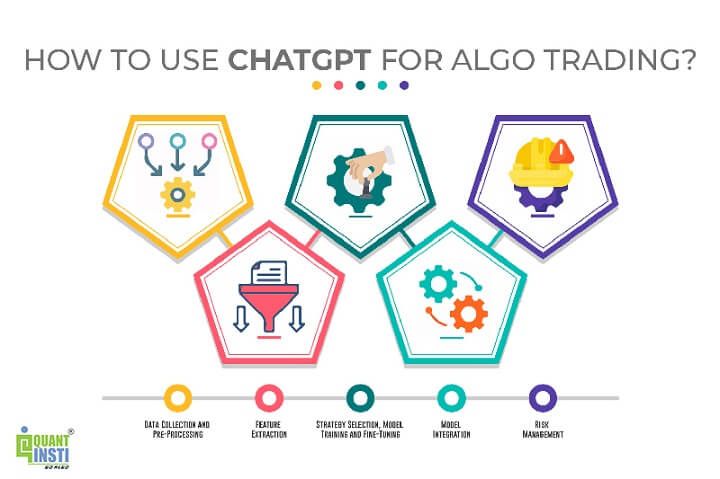Welcome to the world of algorithmic trading, where technology and finance collide to create new opportunities for investing and trading. In this blog, we will explore the exciting world of Algo trading using the power of OpenAI’s ChatGPT model.
With the ability to process vast amounts of data and make informed decisions in real-time, algorithmic trading has revolutionised the financial markets. From automated portfolio management to high-frequency trading, we will dive into the latest trends and techniques used in the industry. So join us as we journey through the exciting possibilities of Algo trading, powered by cutting-edge technology.
The blog covers:
- What is Algo Trading?
- What is ChatGPT?
- How does ChatGPT work?
- Can ChatGPT be used for trading?
- How to use ChatGPT for algo trading?
- ChatGPT for market research
- ChatGPT for stock selection
- ChatGPT for strategy selection
- ChatGPT for backtesting a trading strategy
- ChatGPT for performance analysis
- ChatGPT for risk management
- ChatGPT for deploying an algo trading strategy
- How to use ChatGPT to implement machine learning for algo trading?
- Benefits of ChatGPT in trading
- Limitations of ChatGPT in trading
What is Algo Trading?
Algorithmic trading is a rapidly growing field in finance, where computer algorithms are used to execute trades automatically based on predetermined rules and market conditions. This type of trading is becoming increasingly popular as it offers several benefits over traditional manual trading, such as faster execution, lower transaction costs, and reduced risk.
One of the critical components of algorithmic trading is having a robust and efficient trading architecture with several tools to facilitate automation. In recent years, chatbots have emerged as a popular tool for algorithmic trading, offering traders a more user-friendly and accessible platform. One of the most popular chatbots for algorithmic trading is ChatGPT.
What is ChatGPT?
ChatGPT is a language model developed by OpenAI. ChatGPT stands for Chat Generative Pre-trained Transformer, a deep-learning language model capable of performing various language-related tasks, including text generation, translation, and sentiment analysis.
The ChatGPT can be used for a wide range of applications, including customer service, content creation, and language translation.
The ability of ChatGPT to generate human-like text makes it an exciting development in the field of natural language processing and artificial intelligence.
This makes ChatGPT an excellent research tool for traders who want to automate their trading strategies and execute trades quickly and efficiently.
How does ChatGPT work?
ChatGPT is a conversational AI model that uses a type of deep learning called transformer-based architecture. It works by pre-training a large neural network on a massive corpus of text data, allowing it to learn patterns in language and understand the relationships between words, phrases, and sentences.
When given a prompt, the model generates a response by selecting the most likely following words based on the patterns it has learned during pre-training. This process is repeated multiple times, with the model continually refining its response until it reaches a stopping criterion, such as a maximum length or a specific end token.
The text data used for pre-training can come from various sources, including books, websites, and social media. The goal of pre-training is to create a general-purpose language model that has a broad understanding of language and can generate coherent and contextually appropriate responses to a wide range of prompts.
Once pre-trained, the model can be fine-tuned for specific tasks, such as answering questions, generating creative writing, or translating between languages. Fine-tuning involves retraining the model on a smaller dataset relevant to the specific task, allowing it to adjust its weights and biases to fit the new data better. The result is a model that has been specifically adapted to perform a particular task while retaining its general-purpose language understanding.
Overall, ChatGPT uses deep learning to analyse large amounts of text data and generate human-like responses to prompts in natural language.
Can ChatGPT be used for trading?
Yes, ChatGPT or other language models like it can potentially be used in trading. The ability of these models to process and analyse large amounts of data, understand natural language, and generate human-like responses could be applied to areas such as market analysis, trade execution, and risk management.
For example, ChatGPT or similar models could be used to analyse news articles and social media posts related to a particular stock or market and use that information to generate trading signals or inform portfolio management decisions.
However, it’s important to note that the use of AI in trading, including language models like ChatGPT, is still a relatively new field and is subject to significant uncertainties and risks. There may be limitations to the accuracy and reliability of the predictions generated by these models, and it’s important to evaluate and monitor their performance carefully.
Additionally, the use of AI in trading may raise concerns about fairness, accountability, and ethical considerations, particularly if AI systems make decisions that significantly impact financial markets or investors.
How to use ChatGPT for algo trading?
Using ChatGPT or a similar language model for algo trading would typically involve the following steps:

Data collection and pre-processing
Collect and pre-process large amounts of data relevant to the financial markets you are interested in, such as stock prices, news articles, social media posts, and analyst reports. This data can then be used to train and fine-tune the language model for algo trading.
Feature extraction
Extract relevant features from the data, such as sentiment scores, key phrases, and named entities, to use as input to the model. The language model can then use these features to make predictions or inform trading decisions.
Strategy selection, model training and fine-tuning
If you are not using machine learning for trading, you can use ChatGPT to research several trading strategies available such as mean reversion trading strategies, momentum trading strategies, pairs trading, technical indicator-based strategies etc.
If you are implementing machine learning for your trading, you can train a large language model like ChatGPT on the collected data or fine-tune a pre-trained model on a smaller, task-specific dataset. The goal is to create a model that can accurately understand and generate predictions based on the data.
Model integration
Integrate the trained or fine-tuned language model into your trading system. This may involve writing custom code to interface with the model and extract predictions, as well as implementing strategies for using these predictions in your trading decisions. You may also need to set up a monitoring and evaluation system to ensure that the model is performing as expected and to identify any areas for improvement.
Risk management
Implement proper risk management techniques to ensure that your trading decisions are safe and sound, even if the model predictions are not always accurate. This may include setting stop-loss levels, diversifying your portfolio, and regularly monitoring market conditions and the model’s performance.
Overall, while ChatGPT and other language models have the potential to be useful tools in algo trading, they should be used with caution and in conjunction with other methods and techniques to ensure the best possible outcomes.
Stay tuned for Pat II to learn about ChatGPT for market research.
Originally posted on QuantInsti blog.
Disclosure: Interactive Brokers
Information posted on IBKR Campus that is provided by third-parties does NOT constitute a recommendation that you should contract for the services of that third party. Third-party participants who contribute to IBKR Campus are independent of Interactive Brokers and Interactive Brokers does not make any representations or warranties concerning the services offered, their past or future performance, or the accuracy of the information provided by the third party. Past performance is no guarantee of future results.
This material is from QuantInsti and is being posted with its permission. The views expressed in this material are solely those of the author and/or QuantInsti and Interactive Brokers is not endorsing or recommending any investment or trading discussed in the material. This material is not and should not be construed as an offer to buy or sell any security. It should not be construed as research or investment advice or a recommendation to buy, sell or hold any security or commodity. This material does not and is not intended to take into account the particular financial conditions, investment objectives or requirements of individual customers. Before acting on this material, you should consider whether it is suitable for your particular circumstances and, as necessary, seek professional advice.











![[Gamma] Scalping Please [Gamma] Scalping Please](https://ibkrcampus.com/wp-content/smush-webp/2024/04/tir-featured-8-700x394.jpg.webp)



